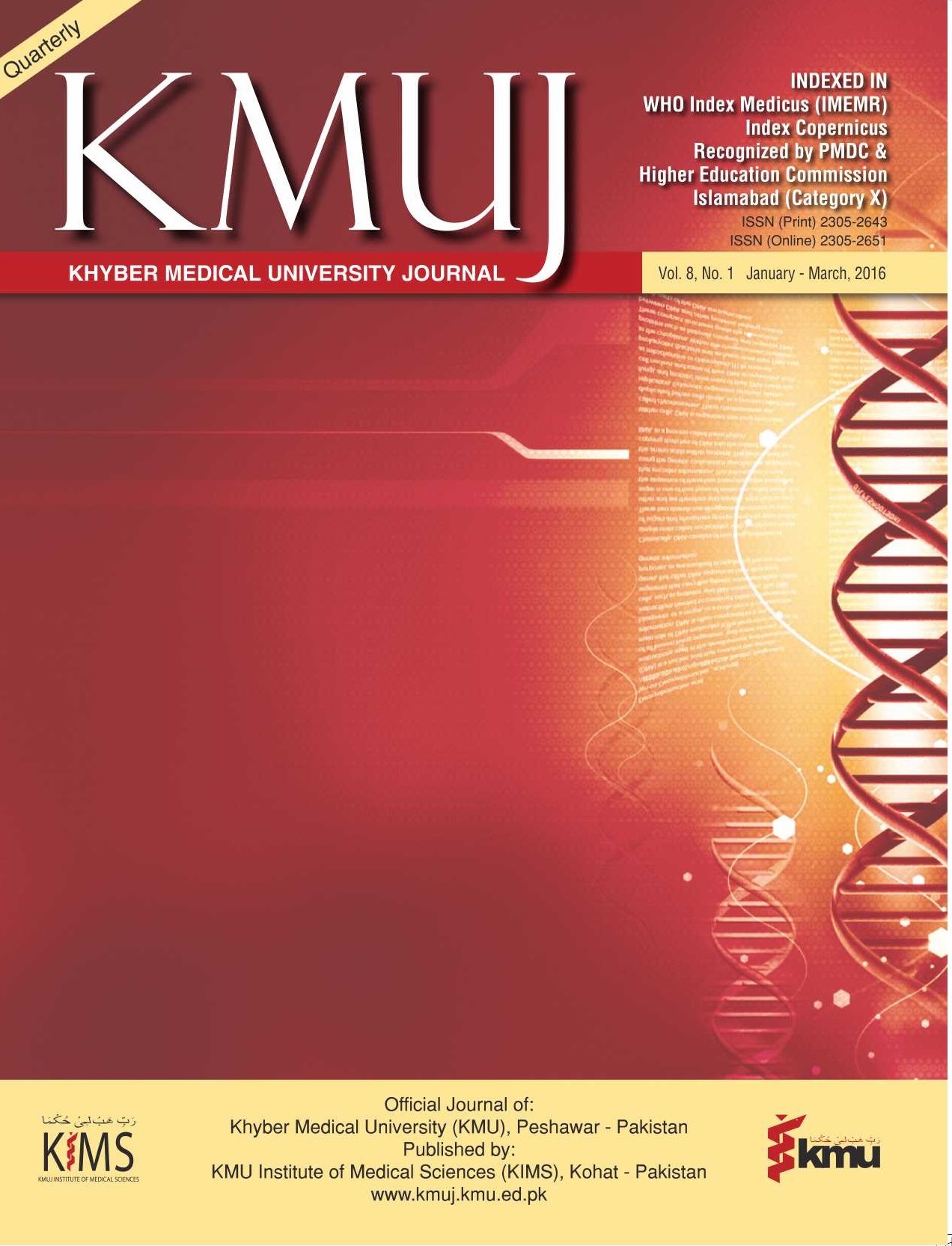A COMPARISON ON EFFICACY OF TRANSCUTANEOUS ELECTRICAL NERVE STIMULATION AND THERAPEUTIC ULTRASOUND IN TREATMENT OF MYOFASCIAL TRIGGER POINTS
Main Article Content
Abstract
OBJECTIVE: To compare the effects of transcutaneous electrical nerve
stimulation (TENS) versus therapeutic ultrasound (US) on pain intensity
and cervical range of motion (ROM) in patients with upper trapezius
myofascial trigger points.
METHODS: Sixty-four patients, selected from Institute of Physical
Medicine & Rehabilitation and Rabia Moon Trust Hospital were divided
into two groups. Group-A was treated with TENS and upper trapezius
stretching while group-B was treated with US and upper trapezius
stretching. Both groups received 12 sessions of treatment, 6 times a
week for two weeks. Pre and post-treatment evaluation of pain intensity and cervical ROM was made through numerical pain rating scale (NPRS) and goniometer.
RESULTS: Mean pre & post-treatment pain intensity score (PIS),
was 5.16±1.09 & 2.62 ± 1.23 in Group-A (p<0.01) and 5.87±1.21 &
0.84±1.01 in Group-B (p<0.05). Mean pre & post-treatment left lateral
flexion (LLF) was 32.01±8.00 & 37.09±6.62 in Group-A (p<0.01) and
31.71±6.76 & 40.12±4.52 in Group-B (p<0.01). Mean pre & post-treatment right lateral flexion (RLF), was 30.87±7.15 & 36.01±6.92 in
Group-A and 32.09±6.54 & 40.81±4.78 in Group-B (p<0.01). Mean
change in PIS was 2.54±0.14 & 5.03±0.2 in Group-A & Group-B respectively (p<0.05). Mean change in LLF, was 5.08±1.38 & 8.41±2.24 in Group-A & Group-B respectively (p <0.05). Mean change in RLF, was 5.14±0.23 & 8.72±1.76 in Group-A & Group-B respectively (p <0.05).
CONCLUSION: Both therapeutic ultrasound and TENS resulted in
significant improvement in pain intensity and cervical ROM, in patients
having upper trapezius trigger points. Ultrasound was clinically more
effective as compared to TENS.
KEY WORDS: Myofascial pain syndromes (Non-MeSH), trapezius muscle (Non-MeSH), trigger points (MeSH), Transcutaeous Electrical Nerve Stimulation (MeSH), Ultrasonography (MeSH).
Article Details
Work published in KMUJ is licensed under a
Creative Commons Attribution 4.0 License
Authors are permitted and encouraged to post their work online (e.g., in institutional repositories or on their website) prior to and during the submission process, as it can lead to productive exchanges, as well as earlier and greater citation of published work.
(e.g., in institutional repositories or on their website) prior to and during the submission process, as it can lead to productive exchanges, as well as earlier and greater citation of published work.
References
Fleckenstein J, Zaps D, Ruger LJ, Lehmeyer
L, Freiberg F, Lang PM, et al. Discrepancy
between prevalence and perceived
effectiveness of treatment methods in
myofascial pain syndrome: Results of a
cross-sectional nationwide survey. BMC
Musculoskelet Disord 2010;11(32):1-9.
Guez M, Hildingsson C, Nilsson M, Toolanen
G. The prevalence of neck pain: A
population-based study from north Sweden.
Acta Orthop Scand 2002;73:455-9.
Rachlin ES, Rachlin IS. Myofascial Pain and
Fibromyalgia. Trigger Point Management.
nd ed. USA: Mosby; 2002: 203, 220.
Simons DG, Travell JG, Simons LS. Myofascial
pain and dysfunction: the trigger
point manual. Upper half of body. 2nd ed.
Baltimore, MD: Williams & Wilkins; 1999.
p. 5, 35, 71.
Lavelle ED, Lavelle WL, Smith HS. Myofascial
trigger points: Med Clin N Am
;91:229-239.
Myburgh C, Lauridsen HH, Larsen AH,
Hartvigsen J. Standardized manual palpation
of myofascial trigger points in relation
to neck/shoulder pain, the influence of clinical
experience on inter-examiner reproducibility.
Man Ther 2011;16(2):136-40.
Fernandez-de-las-Penas C, Alonso-Blanco
C, Miangolarra JC: Myofascial trigger
points in subjects presenting with mechanical
neck pain: a blinded, controlled study.
Man Ther 2007,12:29-33.
Hoyle JA, Marras WS, Sheedy JE, Hart
DE. Effects of postural and visual stressors
on myofascial trigger point development
and motor unit rotation during computer
work. J Electromyogr Kinesiol 2011;
(1): 41-8.
Hong CZ. Myofascial trigger points: Pathophysiology
and correlation with acupuncture
points. Acup Med 2000;18(1):41-7.
Ay S, Dogan SK, Evcik D, Baser OC. Comparison
the efficacy of phonophoresis and
ultrasound therapy in myofascial pain syndrome.
Rheumatol Int 2011;31(9):1203-8.
Jerald KJ. Effects of transcutaneous
electrical nerve stimulation and electrical
muscle stimulation on myofascial trigger
point in upper trapezius: a comparative
study. Rajiv Gandhi University of Health
Sciences. K.T.G College of Physiotherapy.
Bangalore 2006:25.
Dundar U, Solak O, Samli F, Kavuncu V.
Effectiveness of Ultrasound Therapy in
Cervical Myofascial Pain Syndrome: A
Double Blind, Placebo-Controlled Study.
Turkish J Rheumatol 2010;110-15.DOI:
5152/tjr.2010.13
Ardic F, Sarhus M, Topuz O. Comparison of
two different techniques of electrotherapy
on myofascial pain. J Back Musculoskelet
Rehabil 2002;16(1):11-16.
Nagrale AV, Glynn P, Joshi A, Ramteke G.
The efficacy of an integrated neuromuscular
inhibition technique on upper trapezius
triggers points in subjects with non-specific
neck pain: a randomized controlled trial. J
Man Manip Ther 2010;18(1):37-43.
Farrar JT, Young JP, La-Moreaux L, Werth
JL, Poole RM. Clinical importance of
changes in chronic pain intensity measured
on an 11-point numerical pain rating scale.
Pain 2001;94(2):149-58.
Narayanan SL. Textbook of therapeutic
exercises. New Delhi: Jaypee; 2005, 40.
Pillay MG. The treatment of myofascial
pain syndrome using therapeutic ultrasound,
on upper trapezius trigger points:
A double-blinded placebo controlled study
comparing the pulsed and continuous
waveforms of ultrasound. Durban Institute
of Technology. South Africa; 2003:27,72.
Esenyel M, Caglar N, Aldemir T. Treatment
of myofascial pain. Am J Phys Med Rehabil
;79(1):48-52.
Walsh NE, Rogers JN, Patil JJ. Injection
procedures. Rehabilitation medicine.
rd ed. Philadelphia: Lippincott-Raven;
553-610.
Unalan H, Majlesi J, Aydin FY, Palamar D.
Comparison of high-power pain threshold
ultrasound therapy with local injection in the treatment of active myofascial trigger
points of the upper trapezius muscle. Arch
Phys Med Rehabil 2011;92(4):657-62.
Jaeger B, Reeves JL. Quantification of
changes in myofascial trigger point sensitivity
with the pressure algometer following
passive stretch. Pain 1986;27(2):203-10.
